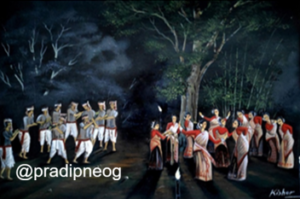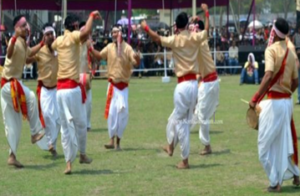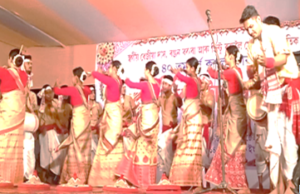Bihu : Origin and Intangible heritages
Dr Pradip Neog*
The Assamese people celebrate mainly 3 agrarian traditional festivals in 3 different stages of cultivation of Kharif-paddy, locally called as Sali-paddy, the main crop of the state. These three festivals are – Bohag-bihu, Kati- bihu and Magh-bihu. These three Bihu festivals befall in 3 different seasons of a year: Bohag-bihu in the spring season, Kati-bihu in autumn, and Magh-bihu in winter season. Out of the three Bihu festivals, Bohag-bihu is celebrated in greater magnitude with prodigious pom and pride.
Origin of Bihu festivals
As postulated by majority of the researchers, celebration of Bohag-bihu festival might be about 5000 years old, and was initiated by Austroasiatic people who were the earliest inhabitant of Assam. They lived in the land of Assam during 3000 BC to 1000 BC. During 1000 BC various groups of Tibeto-Burman people came to Assam, and as a consequence of their immigration Austroasiatic people migrated to Meghalaya and Bangladesh.
At present, people of Assam are multi-ethnic, multi-linguistic and multi-religious. The major ethnic groups include Tibeto-Burman, Indo-Aryan, Tai-Ahom, Kuki-chin, Dravidian, Yogi, Tea-garden labourers, Muslim and Bengali. Majority of these ethnic groups celebrate the Bihu festivals particularly Bohag-bihu most significantly. All the three Bihu festivals are by and large influenced by the cultures of all these ethnic groups. Of course, originally the intangible resources of the Bihu festivals are mainly originated from various ethnic groups of Austroasiatic, Ahom, and Tibeto-Burman people.
Intangible heritages of Bihu festivals
The intangible heritages of the Bihu festivals including rituals, music, dance, songs, games, traditional cuisines, typical snacks, and other festivities are exceedingly extensive and wide-ranging. Traditionally, more than 40 kinds of rituals are archetypally performed in the three Bihu festivals. These rituals reflect rich culture, indigenous technical knowledge (ITKs), age-old philosophies, occupational acumens, religious faiths and livelihood of Assamese people. Majority of the rituals are observable and productive in modern era too.
Assamese people have been organizing dance-cum-musical events for many centuries as integral part of celebrating Bohag-bihu. The traditional dance-cum-musical events are of 3 kinds namely, Gabhoru-bihu, Rati-bihu and Husori. In these three dance-cum-musical events, archetypal dance form called as Bihunach, and distinctive songs called as Bihugeet or Bihunam are performed along typical musical instruments called as Bihubadhya.
Traditionally. Gabhoru-bihu was held in midst of nature during day-time in which girls were participated. Rati-bihu was also held in midst of nature but during night time, and both females and males youths took part. At present, both Gabhoru-bihu, and Rati-bihu are mostly held in modern-day Bihu functions instead in the midst of nature.
Husori is traditionally performed in courtyard of residents. In present era such traditional performance is dwindling and Husori is mostly demonstrated Bihu-functions. Originally, Husori was performed by males only. However, since the decade of 80s of twentieth century females also started participating. Participation of female in Husori changed the original format of the event to a great extent. In the course of time, the changed format has become more popular.
The magnitude and features of the dance, songs and musical instruments of the aforesaid 3 traditional events are enormous and of superlative standard, – superbly alluring and attractive.
Thus, musical intangible resources as well as heritages of Bohag-bihu festival are matchlessly vast, fabulous, splendid and superlative.




Bihu-functions of present era
In present era all the 3 traditional dance-cum-music events extremely dwindled in original context. However, presentation of all the 3 events are going on full swing in the Bihu-functions organized in hundreds of places throughout the state as integral part of celebrating Bohag-bihu. In addition to the bihu events, other items of rich Assamese folk-culture and Assamese modern songs are also presented in the Bihu-functions.


Books consulted
- Dr Pradip Neog (2021). Bihu Festivals: All-inclusive Elucidations. Notion Press, India.
- Joykanta Gandhia, (1997). Hunchari Mukali Bihu Aru Bihunach. Bonolata, Guwahati
- Nitul Changmai (2016). Bihur Itihah aru Parampora. Students’ Stores, Guwahati
- Dr Pradip Neog, (2008). Bihu Binandia. Jyoti Prakashan, Guwahati.
- Dr Pradip Neog, (1987). Rongali Bihur Nitya Geet, Monikut Prakashan, Guwahati.
- Bihu Surashya Sommitty, Assam (2011). Bihu Pratiyogitar Niyamawali.

Dr Pradip Neog is an acclaimed researcher and author of Assamese folk culture.

Leave a Reply